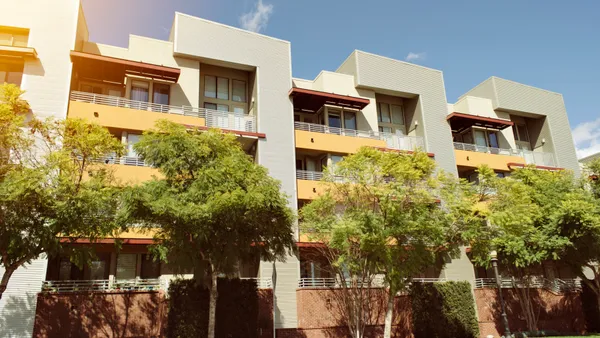Dive Brief:
- Non-traded REITs bought a record $213.9 billion of U.S. apartment buildings last year, according to a new report from Real Capital Analytics. Between 2015 and 2019, these investment groups claimed about 3% of transactions. In 2021, that number shot up to 10%.
- Two of the most active apartment buyers, Blackstone’s non-listed REIT, BREIT, and No. 1 apartment owner Starwood’s SREIT, are in the non-traded REIT space.
- Non-traded REITs seemed to prefer the efficiency of larger transactions, with more than 75% of their acquisitions tied to portfolios. “If I’m raising billions of dollars every month, it's hard to go and buy buildings one at a time,” said Jim Costello, senior vice president at RCA. “I've got too much coming in the door. I can’t deploy it effectively by buying a building in Cleveland and an industrial building in Philadelphia, for instance. The pace of that might not be enough to put the capital to work.”
Dive Insight:
Non-traded REITs, particularly Starwood’s and Blackstone’s entities, continually made headline-grabbing deals in 2021. In December, BREIT bought a $5.1 billion portfolio of affordable housing from AIG. In November, SREIT acquired a 15,460-unit portfolio from Strata Equity Group.
The buying spree continued into 2021 with BREIT slated to purchase Preferred Apartment Communities for $5.8 billion and Resource REIT for $3.7 billion.
Recently, BREIT, along with other company funds, announced the acquisition of Austin, Texas-based American Campus Communities in a $13 billion deal. In the process, it is privatizing the last public student housing REIT.
“They’ve raised a bunch of money,” said Costello. “There are others who want to copy their success and try these multi-billion-dollar-a-month capital raises. There are a lot of folks trying to be active in that space now. They see the success.”
As more buyers crowd into the non-traded REIT space, they will need to look harder to acquire large portfolios or entire companies. “Where are the opportunity sets of taking down portfolios and big firms?” Costello said.
The migration of people to the Sun Belt and the suburbs has opened up new targets for investors, however.
“There's been a huge surge of demand for renters in a lot of new markets,” said Alexander Goldfarb, managing director, senior research analyst of REITs at Piper Sandler & Co. “And it has also highlighted the fact that investors don't need to go into the major cities to buy high rises. There is a lot of value in buying wood-frame apartments and the economic troughs are better because the price points are lower. You're getting a wider potential renter space and that's great for earnings growth.”
To find opportunities, non-traded REITs also look at other sectors of commercial real estate.
There are a lot of public targets where company stock prices are below their property value, according to Goldfarb.
“There is more opportunity,” Goldfarb said. “REIT land has a lot of companies below [net asset value].”
Click here to sign up to receive multifamily and apartment news like this article in your inbox every weekday.











